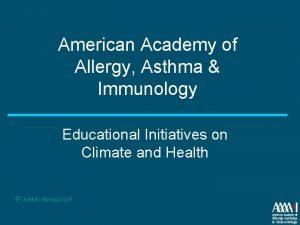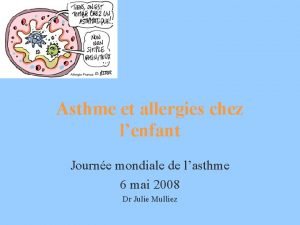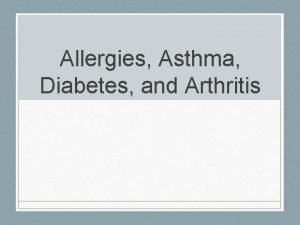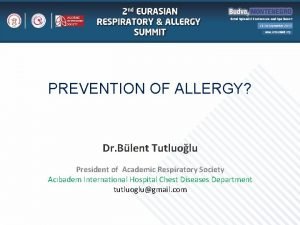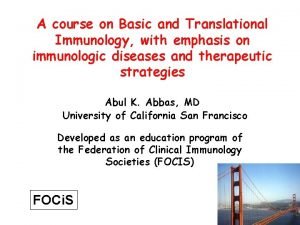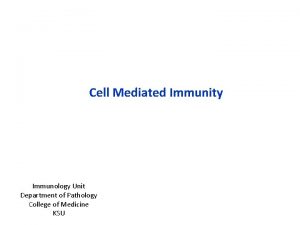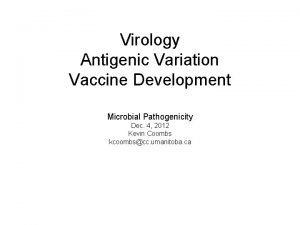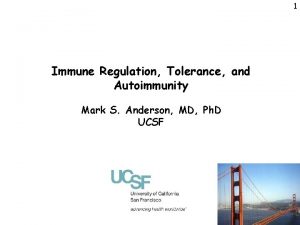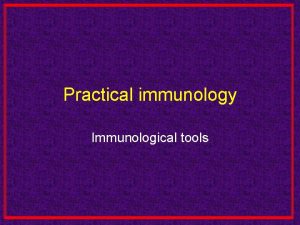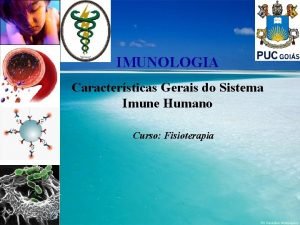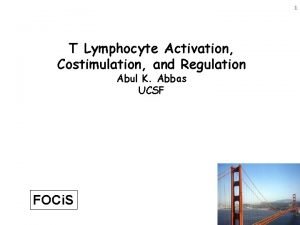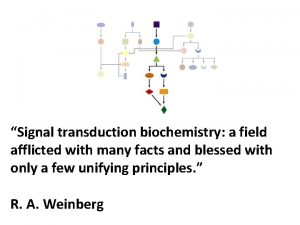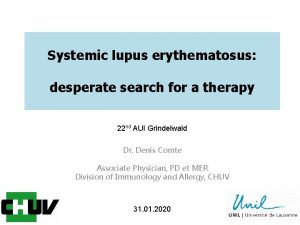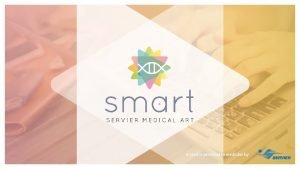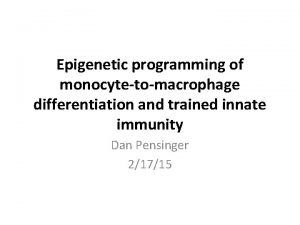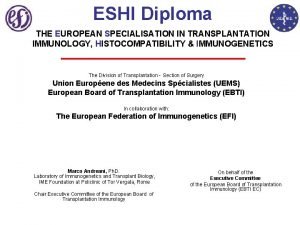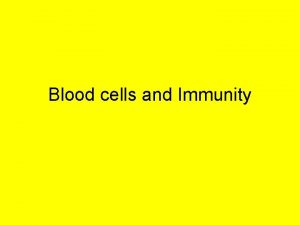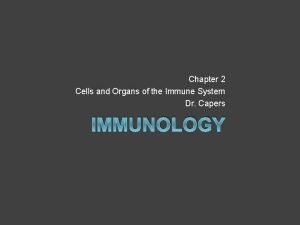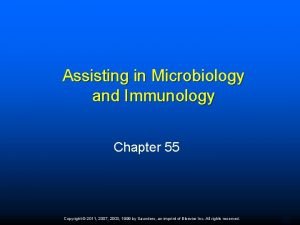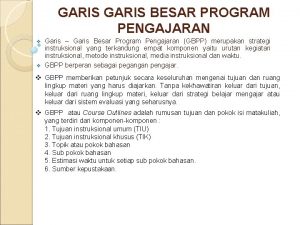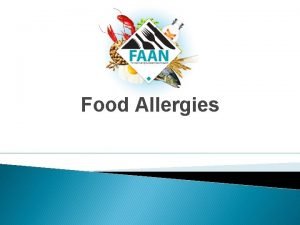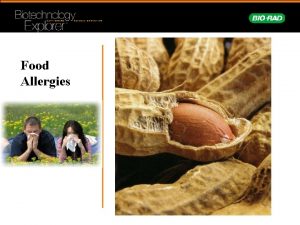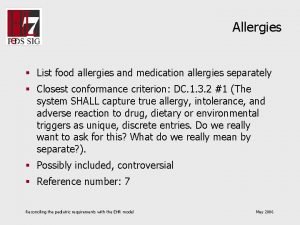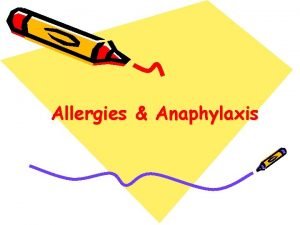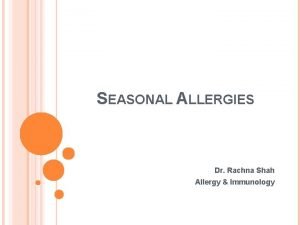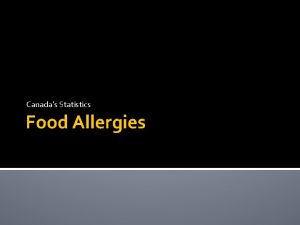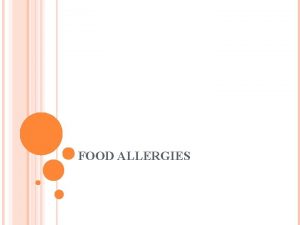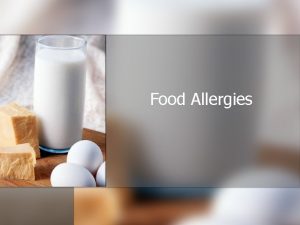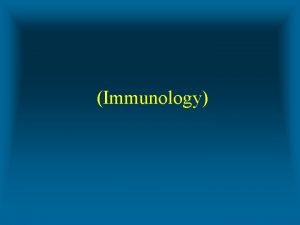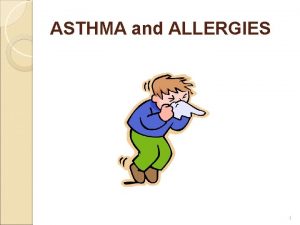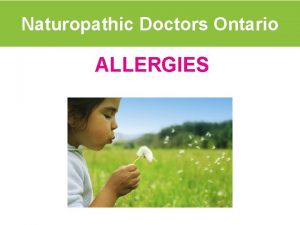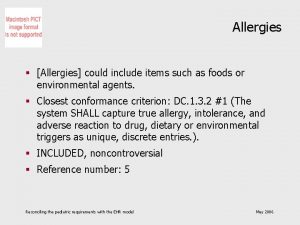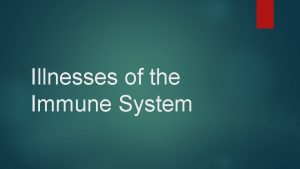Food Allergies Outlines What is food allergy Immunology






































- Slides: 38

Food Allergies

Outlines What is food allergy Immunology concepts What foods causes allergies Possible ways to deal with food allergy Resources for food allergies

Allergy is a specific immunological reaction to a normally harmless substance An allergic reaction produces inflammation, a basic response of the body to injury

The symptoms of allergies to airborne substances include: Sneezing, often accompanied by a runny or clogged nose Coughing Itching eyes, nose and throat Allergic shiners (dark circles under the eyes caused by increase blood flow near the sinuses) Watering eyes Conjunctivitis (an inflammation of the membrane that lines the eyelids, causing red-rimmed, swollen eyes and crusting of the eyelids)

Allergies in developed countries are becoming more common. In the U. S. , food allergies afflict 2 -2. 5% adults and 6 -8% children. 100 -175 people in the U. S. die each year. Death generally result from anaphylactic shock, often to peanuts or tree nuts. More than 160 foods have been associated with allergic reactions.

Foods triggering anaphylaxis in Singaporean children (1992 – 1996) 124 children with acute anaphylaxis at NUH mean age (yrs) 1. Egg and milk 11 % 0. 7 2. Bird’s nest 27 % 4. 5 3. Chinese herbs 7% 5. 0 4. Crustacean seafood 24 % 11. 0 5. Others * 30 % 7. 0 * Chicken, duck, ham, fruits (banana, rambutan), cereals, gelatin Goh et al. Allergy 54, 1999, 78 -92. and spices


What is food allergy? Food allergy is an inappropriate immune response to an otherwise harmless food. Food allergy involves several types of immunological responses. Food allergens are usually proteins. Some foods may contain haptens or haptens carrier (A hapten- a small molecule that has the ability to combine with an Ab or a cellsurface receptor)

Types of food allergies Immediate hypersensitivity with Ig. E which occurs within minutes to a few hours after ingestion of offending foods. l Systemic: Itching, Vomiting, Abdominal cramps, diarrhea and respiratory distress, and in severe cases anaphylactic shock l Localized: hives and eczema or atopy (an umbrella term covering clinical presentations of food allergy etc) Delayed hypersensitivity reactions (>8 hours after ingestion): cellular immunity involving T-lymphocytes and macrophages

What are stages of food allergy or hypersensitivity A. Sensitization: initial meeting of an allergen and the immune system that results in Ig. E production B. Activation of mast cells Ig. E l Non-Ig. E substances (eg. Drugs) l


Understanding Immunological concepts Human body has many defense mechanisms to fight off infectious diseases and other toxic foreign substances. Strong healthy adult human can fight off most of infectious diseases. Ability to fight off disease can be modulated by genetics, age, race and lifestyles (diets, exercise and amount of sleep etc. )

Terminology Allergic reactions are Antigen-Antibody reactions Antigen = a foreign substance Antibody = a protein produced in response to an antigen that is capable of binding specifically to the antigen! Haptens - a small molecule that has the ability to combine with an Ab or a cell-surface receptor.

Understanding Immunological concepts Human body has two categories of defense system l Non specific defenses l l l l Physical barriers (skin and mucous membrane) Chemical barriers (saliva, mucus, gastric juices etc) Cellular defenses (certain cells can eat invadersphagocytes) Inflammation (reddening, swelling and temperature increase of the affected sites) Fever (elevated body temperature) Molecular defenses (interferons or complementary system etc. ) Specific defenses or specific immunity** l Antibodies (many kinds of antibodies for many kinds of antigens)

Understanding Immunological concepts Food allergies is related to specific defenses or specific immunity Immune literary means “free of burden” Actions of the immune system are triggered by antigens (foreign substances). Most antigens are large protein molecules; Some antigens are polysaccharides and few are glycoproteins (carbohydrate and protein) or nucleo-proteins.

There are five classes of Immunoglobulins l l l 1) Ig. G: Main class of antibodies in blood-also from mother-to-child (20%) 2) Ig. A: Small amount in blood, but larger amount in tears, milk, saliva, mucus and the lining tissues 3) Ig. M: First Antibody secreted during the primary response **4) Ig. E (Reagin): Found mainly in body fluids and skin --- Associated with allergy reactions! 5) Ig. D: Found in B-Cell membrane

Nature of Ig. E Allergic Reactions Antigen + Ig. E + Mast cells = Mediator release Mediators= histamine and others

Who makes the immunoglobulin Ig. E? The allergen enters the body and is recognized by s. Ig on a B-lymphocyte. The Blymphocyte proliferates and differentiates into plasma cells that produce and secrete Ig. E against the allergen. Picture credit: used with permission from Dr. Gary E. Kaiser http: //www. cat. cc. md. us/courses/bio 141/lecguide/index. html

What’s next? The next time the allergen enters the body, it cross-links the Fab portions of the Ig. E bound to the mast cell. This triggers the mast cell to degranulate, that is, release its histamine and other inflammatory mediators. Picture credit: used with permission from Dr. Gary E. Kaiser http: //www. cat. cc. md. us/courses/bio 141/lecguide/index. html

Nature of Ig. E Allergic Reactions Antigen + Ig. E + Mast cells = Mediator release Mediators= histamine and others Picture credit: used with permission from Dr. Gary E. Kaiser http: //www. cat. cc. md. us/courses/bio 141/lecguide/index. html

What does histamine do? Vasodilation, increased capillary permeability, bronchoconstriction etc.

Symptoms-Food Allergy* Nausea Diarrhea Abdominal cramps Asthma/rhinitis Vomiting Hives Laryngeal edema Anaphylaxis

What are common allergenic foods? Legumes (Peanuts and Soybeans) Mollusks (snails, mussels, oysters, scallops, clams, squid) Milk Eggs Fish (cod, salmon, haddock etc) Crustacea (shrimp, crawfish, lobster etc. ) Wheat Tree nuts (almonds, walnuts, Brazil nuts etc) Selected food additives

It is not easy…living with food allergies! What would you choose to eat, if you are allergic to milk or dairy products?

Hidden food ingredients in ready made food products! Milk and milk product derivatives Egg and egg derivatives Peanuts, tree nuts and derivatives Fish derivatives (surimi, fish sauce, fish paste etc) Soy and its derivatives

What about food Additives? Sulfur-based preservatives l Sulfites Aspartame (a sweetener)- PKU Monosodium glutamate FD&C Yelow #5 (Tartrazine)

How to deal with food allergy! There is no specific antibody for any specific foods available! People who have food allergy need a total avoidance of the offending foods. Read food ingredient list. Eliminate cross-contamination during cooking and preparation!!!!

Common medications prescribed by doctors epinephrine (relaxes smooth muscle, constricts blood vessels, and stimulates the heart; used for severe systemic reactions); antihistamines (block the binding of histamine to histamine receptors on target cells); sodium cromolyn (prevents mast cells from releasing histamines).

Other causes of allergy-like food problems Microbial products- e. g. histamine – Some food products have high levels of histamine (eg fermented foods) Pharmacological reaction-tyramine, phenylethylamine, cafiene – dose dependent Idiosyncratic reactions – (adverse reactions of drugs etc – dose dependent) Psychological disorders

Food allergy and biotechnology Although it is not easy to predict potential allergenicity of foods derived from GMO!, there are some criteria to go by: Sources of transferred genetic material: While the crops from which staple foods are derived contain tens of thousands of different proteins, relatively few are allergenic. Synthesis of allergenic proteins also depends on the growing conditions and other stress factors. Molecular weight of most known allergens are between 10, 000 and 40, 000.

Are GMOs safe? Bt corn – US, 1996 Roundup® Ready Soybeans – US, 1996 Flavr Savr® tomatoes – US, 1994 http: //cgi. wn. com/? t=worldphotos/viewphoto. txt&action=display&article=3544 3823 “Golden Rice” – Switzerland, 1999

Bt-toxins present in peanut leaves (bottom image) protect it from extensive damage caused by European corn borer larvae (top image)

Roundup Sensitive Plants Shikimic acid + Phosphoenol pyruvate + Glyphosate X Plant EPSP synthase X 3 -Enolpyruvyl shikimic acid-5 -phosphate (EPSP) Without amino acids, plant dies X X Aromatic amino acids

Roundup Resistant Plants Shikimic acid + Phosphoenol pyruvate + Glyphosate Bacterial EPSP synthase Round. Up has no effect; enzyme is resistant to herbicide 3 -enolpyruvyl shikimic acid-5 -phosphate (EPSP) With amino acids, plant lives Aromatic amino acids

Herbicide Resistance Non-transgenics Transgenics

Final Test of the Transgenic Round. Up Ready Corn Before After

Golden Rice have been this obtained that accumulate of to 37 µg/g carote of which 31 µg/g is ß-carotene (as compared to the first generation where only 1. 6 µg/g were obtained in the greenhouse and 6 µg/g in average in a

Flavr Savr® Tomatoes Calgene, Inc. developed a genetically modified tomato that was approved for market by the FDA in 1994. The Flavr Savr® tomato has an extra copy of a gene that codes for the enzyme polygalacturonase (PG), except it has been inserted in the antisense orientation (essentially, in backwards order). The PG enzyme is responsible for the breakdown of pectin within the cell walls of plants, which causes fruits to become soft as they ripen. By incorporating the antisense PG gene, the expression of PG in ripening fruit is decreased. The result of this genetic alteration is tougher skin.
 American academy of allergy asthma and immunology 2018
American academy of allergy asthma and immunology 2018 Arthritis and food allergies
Arthritis and food allergies Food allergies and arthritis
Food allergies and arthritis Food allergy testing auckland
Food allergy testing auckland Beta glucan allergies
Beta glucan allergies Aliments histamino-libérateurs
Aliments histamino-libérateurs Allergy to hair dye icd 10
Allergy to hair dye icd 10 Abbas basic immunology
Abbas basic immunology Kuby immunology
Kuby immunology Baltimore classification
Baltimore classification Cellular and molecular immunology
Cellular and molecular immunology Bmc immunology impact factor
Bmc immunology impact factor Avidity in immunology
Avidity in immunology Trends in education
Trends in education Abbas basic immunology
Abbas basic immunology Tumor immunology
Tumor immunology Janus kinase
Janus kinase Wiki
Wiki Sle criteria 2020
Sle criteria 2020 Server medical art
Server medical art Nature reviews immunology
Nature reviews immunology Pcams immunology
Pcams immunology Diploma in immunology
Diploma in immunology Nature reviews immunology
Nature reviews immunology History of immunology
History of immunology Nature reviews immunology
Nature reviews immunology 17 tc
17 tc Pals immunology
Pals immunology Assisting in microbiology and immunology
Assisting in microbiology and immunology Antigen antibody
Antigen antibody Fea course
Fea course Fraunhofer institute for cell therapy and immunology
Fraunhofer institute for cell therapy and immunology Immunology ppt template
Immunology ppt template Define:visible
Define:visible Anime
Anime Teaching outline
Teaching outline Exegetical outline
Exegetical outline A business plan is a document that outlines
A business plan is a document that outlines Congestion intestinal
Congestion intestinal
